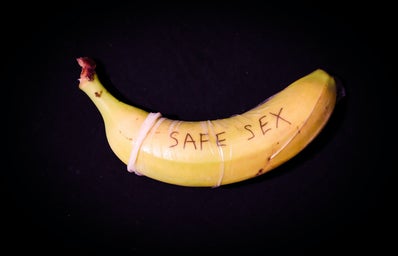I’ll be the first to say that people with STDs receive bad reputations for seemingly no reason. There are endless misconceptions about STDs, STIs, and the people who have them. To clarify, it is not my intention to scare you–my lovely little readers– into abstinence, but instead, to educate you on the truth about STDs and how you can help break the stigmatization.
Sexually Transmitted Diseases (STDs) are also known as Sexually Transmitted Infections (STIs), both of which are “umbrella terms” used to describe infections spread through vaginal, oral, or anal intercourse.
You might be reading this because the threat of contracting an STD has crept into your brain or simply because you want to understand what these diseases are, but do not fret, STDs sound more menacing than they are. I was never properly educated about STDs, as the topic was much too taboo to discuss; the sexual education I received was like the scene in Mean Girls when Coach Carr said not to have sex because “you will get pregnant and die”. Thus, let’s break down those misconceptions and attempt to understand the truth.
Myth #1: “You’ll know if your partner has an STD.”
Truth: Many STDs present asymptomatically.
It can be impossible to determine if a person has an STD just by looking at them, and sometimes, the person who has it might not even be aware. STDs often present a variety of symptoms, and strangely enough, this includes being asymptomatic–having or presenting no apparent signs of an ailment. Though the symptoms can be invisible, the bacteria is still there, and you can pass the infection to your sexual partners through oral, anal, vaginal, or even simple sexual conduct like heavy petting and kissing. Typical warning signs can include sores or bumps on genitalia, mouth, or rectal areas. On average, visible symptoms appear within the first few days or weeks after transmission, but they can take months or even years to develop. To properly diagnose most STDs, blood tests are necessary. If you begin to suspect you might have an STD, get tested as soon as possible. For students at CU, the Wardenburg Health Center offers confidential testing for numerous STDs like HIV, Chlamydia, Gonorrhea, Syphilis, and free HPV testing.
Myth #2: “Only ‘nasty’ people have STDs.”
Truth: STDs don’t discriminate.
Whether you’re being intimate with your first partner or your 50th, STDs can always enter the bedroom. I say this not to cause anxiety but to bring the harsh truth to light. In any sexual interaction, the risk of getting an STD exists, but most are treatable, and certain ones are curable. Contracting an STD can feel embarrassing and isolating, but in reality, they are extremely common. According to HealthCentral, about one in four college students have an STD by the time they graduate.There are around 20 million STD and STI diagnoses each year in the United States, with half of those diagnosed being patients between 15 and 24 years old. The lack of sexual education throughout high school is one of the main reasons why college students are at such high risk. As a student—with one or more sexual partners—practicing safe sex with condoms, dental dams, and getting tested regularly reduces the risk of infections. But there’s no need to worry as I, the ultimate master of all things research and anatomy, am here to provide sexual education for all students at CU!
Myth #3: “HIV is a gay disease.”
Truth: Any person can contract HIV, regardless of sexual orientation.
HIV, formally known as Human Immunodeficiency Virus, is defined by the CDC as “a virus that attacks the body’s immune system. If HIV is not treated, it can lead to AIDS (acquired immunodeficiency syndrome).” Certain members of the LGBTQIA+ community are discriminated against and disproportionately affected by HIV. According to the Human Rights Campaign, one in six gay and bisexual men will be diagnosed with HIV in their life. Transgender women are 49 times more likely to be affected than the general population. In a society where it is legal to discriminate against someone due to their sexual orientation, many are affected by this bias and must engage in survival sex work to provide for themselves. Unfortunately, there is no cure for HIV, but due to improvements in medicine, treatments are available to control symptoms. However, a 2014 Kaiser Family Foundation survey deduced that 15% of gay and bisexual men received improper treatment from a medical professional, and 30% felt uneasy speaking about their sexual habits with healthcare workers. Despite all the apparent challenges faced by those affected by HIV, current tests and medications are more efficient than ever before. As members of the LGBTQIA+ community and as allies, educating everyone on HIV and ending the stigma are the highest priorities.
Myth #4: “STDs go away on their own.”
Truth: Untreated STDs can cause permanent damage to your reproductive organs.
It is highly unlikely that STDs will go away on their own, but most have medication to treat them. STDs like Chlamydia and Gonorrhea generally do not present with symptoms, but if left untreated, they can cause a considerable amount of other diseases. Untreated Chlamydia can lead to Pelvic Inflammatory Disease (PID) which can cause pregnancy complications among women, chronic pelvic pain, and infertility. Gonorrhea will not go away without medical assistance and similarly can lead to PID. While certain STDs may go away with no medical assistance, like Human Papillomavirus (HPV), it is always best to get evaluated by a professional before any permanent damage has happened.
Myth #5: “Condoms always protect you from STDs.”
Truth: Condoms can help prevent STDs, but it is not guaranteed.
This statement might invalidate everything you were taught about condoms, but sadly, they are not 100% effective in preventing the transmission of STDs. Condoms do minimize risk, but some STDs spread through skin-to-skin contact. If you’re using it correctly, a condom will protect you from many of the most common STDs, like chlamydia, gonorrhea, HIV, and hepatitis B. But condoms will not protect you from herpes, genital warts, and syphilis because they are spread through physical contact. Even with this, one of the most vital yet forgotten actions of protecting yourself from an STD is communication between you and your partner. Hiding your possible infection is so outdated; the new vibe is being open and honest with the people you take to bed.
Being sexually active as a young adult can be accompanied by some consequences, but do not allow your fears to deny you your right to physical intimacy. The best way to battle fear of STDs and STIS is with the greatest power you can have: knowledge. After reading my educating yet incredibly intriguing guide to all things STDs, you are officially a graduate of—what could be your first— sexual education course!






